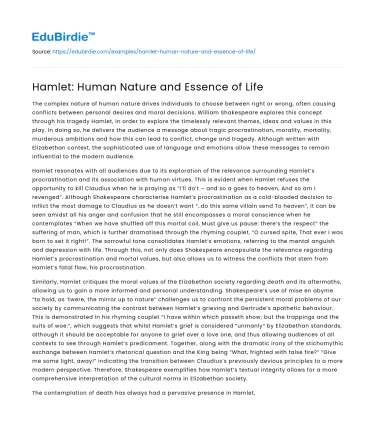The complex nature of human nature drives individuals to choose between right or wrong, often causing conflicts between personal desires and moral decisions. William Shakespeare explores this concept through his tragedy Hamlet, in order to explore the timelessly relevant themes, ideas and values in this play. In doing so, he delivers the audience a message about tragic procrastination, morality, mortality, murderous ambitions and how this can lead to conflict, change and tragedy. Although written with Elizabethan context, the sophisticated use of language and emotions allow these messages to remain influential to the modern audience.
Hamlet resonates with all audiences due to its exploration of the relevance surrounding Hamlet’s procrastination and its association with human virtues. This is evident when Hamlet refuses the opportunity to kill Claudius when he is praying as “I’ll do’t – and so a goes to heaven, And so am I revenged”. Although Shakespeare characterise Hamlet’s procrastination as a cold-blooded decision to inflict the most damage to Claudius as he doesn’t want “..do this same villain send To heaven”, it can be seen amidst all his anger and confusion that he still encompasses a moral conscience when he contemplates “When we have shuffled off this mortal coil, Must give us pause: there’s the respect” the suffering of man, which is further dramatised through the rhyming couplet, “O cursed spite, That ever I was born to set it right!”. The sorrowful tone consolidates Hamlet’s emotions, referring to the mental anguish and depression with life. Through this, not only does Shakespeare encapsulate the relevance regarding Hamlet’s procrastination and mortal values, but also allows us to witness the conflicts that stem from Hamlet’s fatal flaw, his procrastination.
Save your time!
We can take care of your essay
- Proper editing and formatting
- Free revision, title page, and bibliography
- Flexible prices and money-back guarantee
Similarly, Hamlet critiques the moral values of the Elizabethan society regarding death and its aftermaths, allowing us to gain a more informed and personal understanding. Shakespeare’s use of mise en abyme “to hold, as ’twere, the mirror up to nature” challenges us to confront the persistent moral problems of our society by communicating the contrast between Hamlet’s grieving and Gertrude’s apathetic behaviour. This is demonstrated in his rhyming couplet “I have within which passeth show; but the trappings and the suits of woe.”, which suggests that whilst Hamlet’s grief is considered “unmanly” by Elizabethan standards, although it should be acceptable for anyone to grief over a love one, and thus allowing audiences of all contexts to see through Hamlet’s predicament. Together, along with the dramatic irony of the stichomythic exchange between Hamlet’s rhetorical question and the King being “What, frighted with false fire?” “Give me some light, away!” indicating the transition between Claudius’s previously devious principles to a more modern perspective. Therefore, Shakespeare exemplifies how Hamlet’s textual integrity allows for a more comprehensive interpretation of the cultural norms in Elizabethan society.
The contemplation of death has always had a pervasive presence in Hamlet, forming the basis of conflict within the play. Although Shakespeare explores the inevitability of mortality by emphasising that “All that lives must die, Passing through nature to eternity.” through the use of constant symbolisms and imagery of death. Shakespeare also examines the “debt the living owe to the dead” with the constant appearances of the ghost serving as a catalyst for the vengeance of his deceased father. The characterisation of Hamlet as the procrastinator opens us to the moral interpretation of duties and responsibilities, evident through the dichotomies of the “To be or not to be” soliloquy through phrases such as “to suffer The slings and arrows of outrageous fortune, Or to take arms against a sea of troubles”. This challenges the contemporary perceptions of death by questioning the potential advantages regarding suicide compared to committing murder. These pervasive techniques outline messages surrounding our duties and responsibilities and serve to highlight the unity of Hamlet as a whole.
Shakespeare’s exploration of the susceptibility of man to corruption and its detrimental consequences resonate with the audiences about the fundamental issues of ambition. As seen in Hamlet, Claudius is given villainous characteristics through the fatal flaw of excessive ambition, murderous intent and for “rotting” Denmark. As the play progresses, the audience is able to see that Claudius takes advantages of the murder of his own brother to seize the crown and consolidate power as his clearly rehearsed speech of “Though yet of Hamlet our dear brother’s death…” reveals his inherently corrupt and ambitious nature. Thus, Shakespeare explores the fact that humanity’s sinful acts ultimately lead to unfavourable consequences.
Likewise, social corruption involving dishonesty and immoral behaviour can also provoke individuals, which leads to actions that may have destructive ramifications on society. Shakespeare reveals this message through the protagonist, Hamlet whose high intelligence results in internal conflicts that prevents his corruption. In Hamlet’s first soliloquy, he immediately establishes Denmark as an “unweeded garden” where “things are rank and gross”, alluding to social corruption, especially Gertrude’s incestuous marriage to Claudius. This is further exemplified through dramatic irony in “Denmark’s a prison” and the fact that Claudius is a “smiling damned villain! Furthermore, the recurring motif of poison and disease symbolises dishonesty and corruption whilst the repetition of “O God, God” highlights Hamlet’s disgust at Denmark’s current situation. Hamlet’s lack of action delivers us a message about the deception and dishonesty around us and elements of the corrupt nature of Denmark that is reflected in our own society.
Thus, it is clearly shown in this tragedy that Hamlet is, in the naturalistic sense, a vessel for ideas and philosophies. “Hamlet” portrays the quintessential human values of identity and morality in a manner that allows it to transcend time due to the insight it brings to the audience of all contexts through an intricate exploration of procrastination, duplicity and the transience of life.






 Stuck on your essay?
Stuck on your essay?

